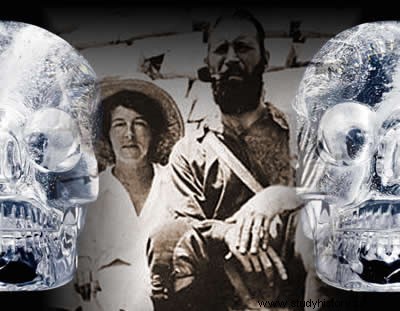
By Rainer Sousa
The glamorization of the material culture of other peoples is a very common practice in many strongholds of western culture. Permeated by an interest that intensified in the 19th century, with the imperialist wave that determined the arrival of colonists in different parts of the planet, the discovery of priceless treasures and artifacts began to foster the greed of explorers and the curiosity of many others. After all, what is the complexity and resigned value within ancient and mysterious cultures?
Some 20th century explorers, fueled by the provocation of this question, began to report the existence of mysterious crystal skulls. Many speculate that these skulls did not match the technical ability of the ancient peoples in which they were found. Such incompatibility ended up serving as fuel for the development of beliefs that believe in the healing power of these pieces or even their sending by creatures from other planets.
In 1878, an eleven-centimeter, three-pound quartz skull was offered to the Museum of Ethnography at the Trocadero Palace. Later, it was acquired by the French museum Quai-Branly, which named the piece “the skull of Paris” and determined its Aztec origin. Even more famous is the “Skull of Frederick Albert Mitchell-Hedges”, which announced the discovery of a crystal skull in a temple found in Belize.
According to this explorer's account, the curious artifact was found by his daughter Anna, on the exact day that the young woman turned 17 years old. According to the young woman, the skull would have the power to pass on and concentrate the knowledge of ancient priests who lived in the region of origin of the artifact. In his memoirs, Frederick Albert points out that many of those who doubted the veracity of the discovery died and that their real powers could not be revealed.
In addition to these two cases, another skull housed at the Smithsonian has the largest measurements of any crystal skull cataloged around the world. Mysteriously received by the post office, the sender of the piece only wrote a small letter saying that it had been acquired a long time ago in Mexico City, in the 1960s. Unlike the other more well-known skulls, this one has a more whitish color.
While many are weaving exoteric and mystical theories about crystal skulls, many other members of the scientific community seek to attest and unravel this whole mystery. In the 1970s, art restorer Frank Dorland claimed that the “Mitchell-Hedges skull” was mysteriously constructed over three centuries. For this scholar, the richness of detail and the complexity of the piece were proof that the crystal skull required slow and careful work.
However, recent research shows that these pieces could not be produced by the type of instrumentation common to pre-Columbian peoples. The skulls in London and Paris would have been made with Brazilian rock crystal, in Germany, between the 1860s and 1890s. The use of metal instruments and the complexity of the carving presented cannot correspond to the various characteristics that define ancient cultures. materials present throughout the American continent.
With regard to Mitchell's famous skull, skeptical Joe Nickell's documentary investigation was enough to completely dispel the myth. According to the investigator in the case, the crystal skull had been purchased for four hundred pounds from an arts dealer named Sidney Burney. Thus, the mystery of the crystal skulls is nothing more than the beautiful anecdote of a fake brilliant.
Take the opportunity to check out our video lesson related to the subject:
